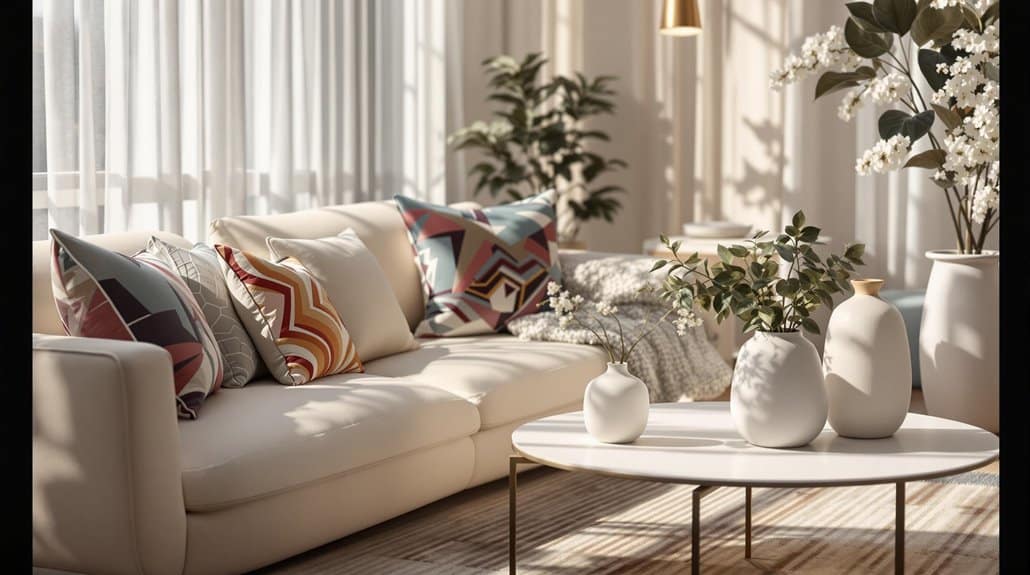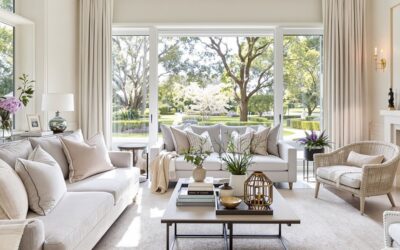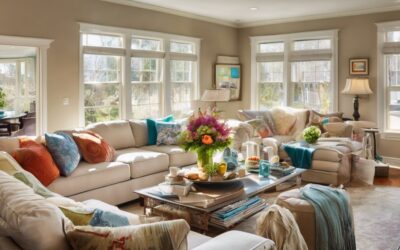Key Takeaways
- Home staging enhances property appeal, helping homes sell 73% faster and often for $40,000 above the listing price.
- Professional staging offers design expertise and resources, while DIY staging allows for cost savings and personal expression.
- Effective staging techniques include decluttering, optimizing lighting, and arranging furniture to highlight features and promote conversation.
- Common mistakes in staging include overcrowding spaces, using outdated decor, and neglecting necessary repairs that detract from the home’s appeal.
- Current market trends indicate a steady growth in home prices and increasing buyer interest in sustainable, multipurpose spaces.
What Is Home Staging?
Home staging is a strategic and artistic process designed to improve a property’s appeal, ultimately facilitating a quicker sale at a higher price. Often referred to as house staging, property staging, or property styling, this art form amplifies visual appeal to attract potential buyers. The process begins with a consultation, where a professional stager assesses the home and prepares a tailored proposal.
By depersonalizing spaces and highlighting the property’s best features, stagers create an inviting atmosphere that resonates with a targeted audience. This meticulous attention to detail transforms homes into functional, welcoming environments, serving as a crucial element of a broader marketing strategy. Ultimately, effective home staging fosters a sense of belonging for prospective buyers.
Notably, homes that are staged often sell 73% faster than those that are not, making it a vital investment for sellers.
Why Is Home Staging Important?
Effective home staging plays a pivotal role in the property market by significantly enhancing the appeal of a property. It allows buyers to picture their lives within the space, fostering a heartfelt connection that can lead to quicker, more lucrative sales. Staged homes often command higher sale prices—an average of $40K over the list—and tend to sell 73% faster than their non-staged counterparts. Additionally, staging showcases engaging move-in-ready homes, which further captivates potential buyers. Understanding Florida’s real estate market dynamics can also help sellers select the best staging strategies to attract buyers.
| Aspect | Staged Homes | Non-Staged Homes |
|---|---|---|
| Average Sale Price | $40K over list price | Lower than staged |
| Time on Market | 33-50% less | Longer duration |
| Buyer Engagement | 40% more likely to view | Less interest |
| Visualization Ease | 82% ease for buyers | Harder to visualize |
| ROI | 5-15% | Lower return |
Benefits of Home Staging
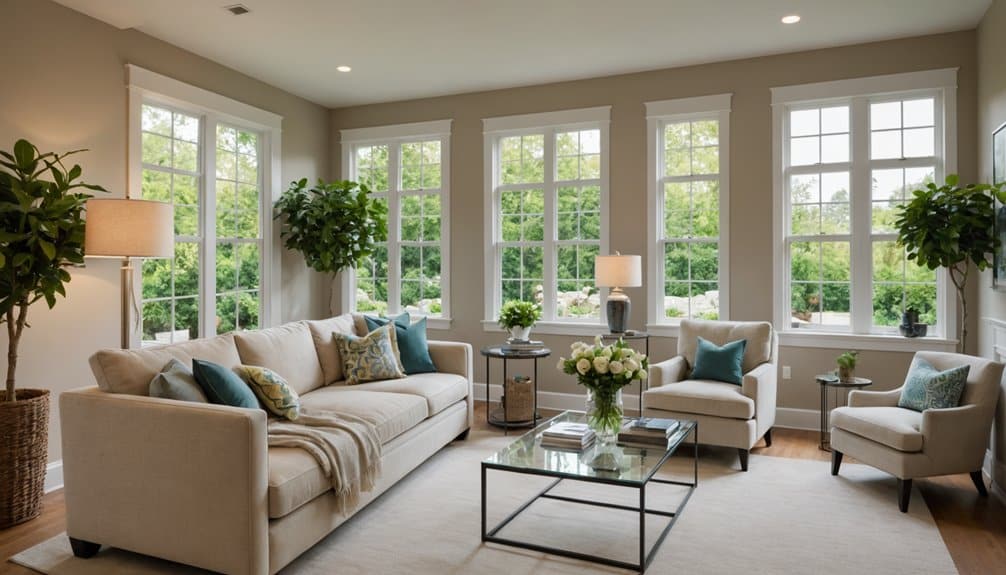
Staging a property offers a multitude of benefits that can significantly impact the selling process. By improving a home’s appeal, staging not only attracts potential buyers but also creates a heartfelt connection that helps them imagine their future in the space. Here are some key advantages of home staging:
- Faster sales: Staged homes typically sell more quickly.
- Higher perceived value: Staging raises the total value, often leading to better offers.
- Broader market appeal: Staging broadens the target audience, appealing to diverse buyers.
- Strategic presentation: It showcases the home’s best features while minimizing flaws. Additionally, effective staging can highlight key selling points that resonate with buyers and enhance their emotional connection to the house.
- Financial benefits: Staged homes can command higher sale prices and reduce carrying costs. Additionally, staged homes sell 73% faster than their non-staged counterparts, reflecting the significant impact of staging on market performance.
Incorporating staging into your selling strategy can significantly improve your outcomes in the housing market.
Key Statistics on Staging
A wealth of compelling statistics underscores the impact of home staging and highlights its effectiveness in the property market. Staging improves a property’s appeal and greatly influences its sale price and speed.
| Statistic | Impact |
|---|---|
| 85% of realtors agree staging sells faster | Staged homes sell 73% quicker |
| Staged homes sell for 1-10% more | Average increase of $40,000 over the list price |
| 95% of buyers search online | Staging increases online visibility |
Investing in staging can yield an extraordinary return on investment, often exceeding 550%. These statistics make it clear that staging is a strategic move for sellers who aim to optimize their home’s potential and foster a sense of belonging for prospective buyers. Additionally, 65% of realtors believe staging leads to higher selling prices, making it a pivotal aspect of the selling process. Understanding the importance of financial capacity can further enhance the effectiveness of staging when buyers are evaluating properties.
Professional Staging vs. DIY

How do homeowners decide between professional staging and a DIY approach when preparing their property for sale? Each option presents distinctive benefits and challenges.
Professional Staging Advantages:
- Design expertise guarantees current trends are reflected.
- Access to resources like furniture rentals improves appeal.
- Quick turnaround allows for rapid market entry.
- A high return on investment can outweigh costs.
- Extensive services cover all aspects of staging.
DIY Staging Advantages:
- Cost savings are significant compared to hiring professionals.
- Complete control over the process fosters individual expression.
- Flexibility allows homeowners to work at their own pace.
- Learning opportunities arise through research.
- Budget-friendly solutions can utilize existing decor. Additionally, homeowners who opt for DIY staging may gain valuable skills in home staging and design through the experience.
Ultimately, the choice depends on the homeowner’s priorities, budget, and time constraints.
How to Stage Your Home
Staging your home effectively involves employing key techniques that improve its appeal while ensuring a clutter-free environment. By focusing on crucial decluttering tips and strategic furniture arrangements, you can create a welcoming atmosphere that resonates with potential buyers. This thoughtful approach not only highlights your home’s best features but also facilitates a heartfelt connection for those viewing the space.
Additionally, evaluating the home’s condition can help identify necessary repairs that further enhance its appeal. To maximize your efforts, consider enhancing curb appeal through landscaping and minor exterior updates, as first impressions are crucial in attracting potential buyers.
Key Staging Techniques
Transforming a home into an inviting space is essential for attracting potential buyers, and employing effective staging techniques can make all the difference. Focus on creating a cohesive and warm atmosphere throughout your home by implementing the following key staging techniques:
- Living Room: Remove bulky furniture and use neutral tones to improve space.
- Kitchen: Neutralize and declutter countertops to help buyers visualize. Staging can help buyers feel emotionally connected to the property, enhancing their interest.
- Bedroom: Use fresh bedding and warm lighting to create a cozy ambiance.
- Outdoor Areas: Increase curb appeal with colorful flowers and clean surfaces.
- Lighting: Provide ample lighting throughout to highlight each room’s features.
Essential Decluttering Tips
Creating an inviting atmosphere is only part of the equation when preparing your home for sale; effective decluttering is crucial for showcasing the space. Begin by tackling one room at a time, starting with high-traffic areas like the living room and kitchen. Remove unnecessary furniture to improve the perception of space, and utilize storage bins to organize belongings.
In the living room, clear individual items and excessive decor; in the kitchen, declutter countertops. Don’t overlook hidden areas such as closets and cabinets, which can significantly impact impressions. Engaging the whole family can make the process enjoyable and efficient.
Remember, maintaining the decluttered state is essential to guarantee your home remains appealing to prospective buyers.
Essential Tips for Effective Staging
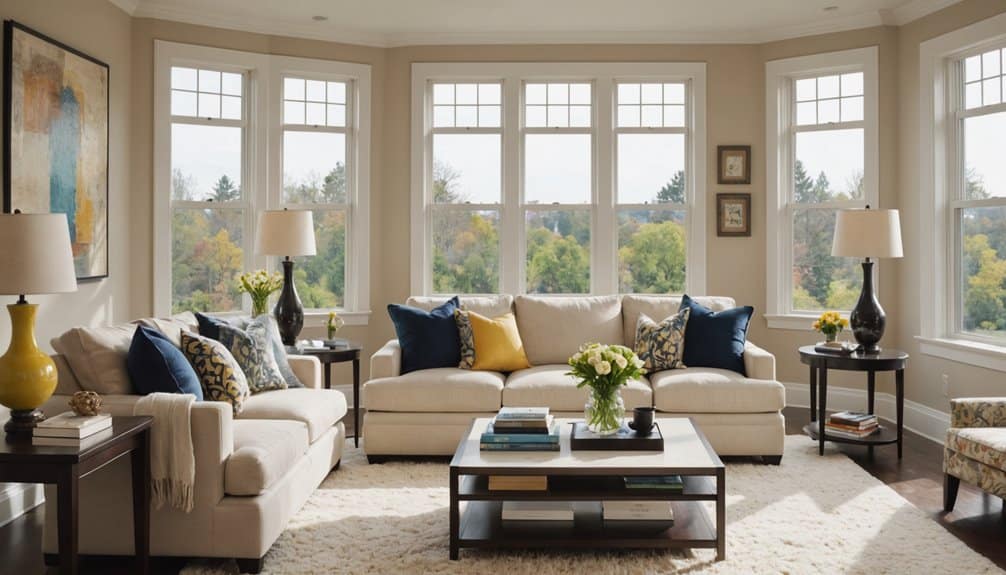
Effective home staging is a critical element in showcasing a property to potential buyers. By enhancing the space, you create an inviting atmosphere that resonates with prospective homeowners. Here are vital tips to guarantee effective staging:
- Declutter and depersonalize: Remove excess furniture and individual items to create a neutral environment.
- Optimize lighting: Amplify natural light and update fixtures to brighten the space.
- Strategically arrange furniture: Promote conversation and flow while highlighting key features.
- Enhance ambiance: Incorporate greenery and fresh decor to create warmth and character.
- Define functional areas: Clearly showcase each room’s purpose to appeal to buyers’ needs.
Common Mistakes to Avoid
Although staging a home can significantly improve its appeal, many sellers fall prey to common mistakes that undermine their efforts. Overloading a space with furniture or decor can create a cluttered, uninviting atmosphere. It’s essential to avoid individual items and outdated decor that may alienate potential buyers.
Furthermore, visual elements like hanging pictures too high or using small rugs can disrupt the flow and make spaces feel cramped. Curtains should reach the floor to improve room height, while repairs must be addressed to maintain a polished appearance. By creating a neutral, organized environment, sellers can help buyers imagine themselves in the home, ultimately fostering a sense of belonging and attraction.
Additionally, understanding Florida’s Homestead Exemption can provide financial stability, making the house even more appealing to prospective buyers.
Understanding Market Trends
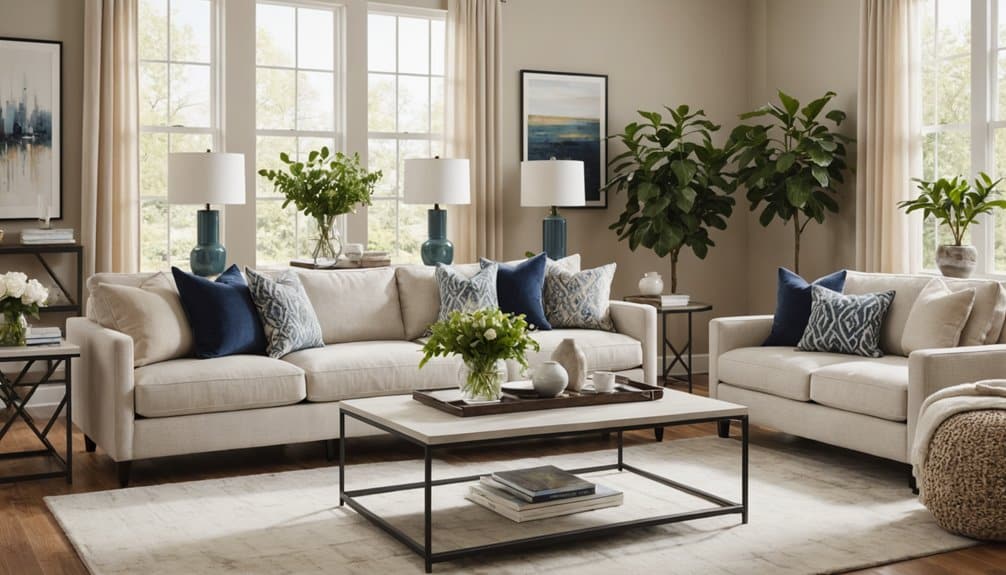
Understanding market trends is crucial for effective home staging in today’s competitive genuine estate landscape. By staying attuned to current buyer preferences, such as the demand for eco-friendly materials and multipurpose spaces, stagers can tailor their approach to meet evolving expectations. Recognizing these dynamics not only improves the property’s appeal but also supports faster sales and potentially higher offers. Additionally, the growing interest in larger homes with outdoor spaces reflects a shift in lifestyle preferences driven by remote work trends.
Current Market Dynamics
As the housing market evolves, staying attuned to current dynamics becomes essential for both buyers and sellers. Understanding these trends can help navigate the complexities of genuine estate in 2025:
- Home prices are predicted to grow slowly, averaging between 1.3% and 3.6%.
- Mortgage rates may stabilize around 6%, enhancing borrowing affordability.
- Housing inventory is gradually increasing, primarily from new construction.
- It’s expected to remain a seller’s market in many areas due to limited inventory.
- Existing home sales could rise by 9%, indicating growing buyer interest.
Buyer Preferences Trends
How do changing buyer preferences shape the landscape of home staging in today’s market? Today’s buyers prioritize sustainability, necessitating the use of eco-friendly materials and energy-efficient features in staging homes. Integrating natural elements, such as live plants and sustainable furnishings, fosters an inviting atmosphere that resonates with environmentally conscious purchasers.
Furthermore, versatile spaces, including family-friendly zones and home office areas, cater to evolving lifestyle needs, especially for remote workers and families. Understanding demographic trends further refines staging strategies, appealing to millennials with modern designs and catering to empty nesters seeking luxury. By aligning staging practices with these preferences, homeowners can improve property appeal, ensuring their listings stand out in a competitive market while fostering a sense of belonging for potential buyers.
Costs Associated With Staging
While the investment in home staging can vary significantly based on several factors, it is essential to recognize that the costs associated with staging a property can play a critical role in its market appeal. Understanding these costs helps sellers make informed decisions that can improve their home’s attractiveness and potential sale price.
- Average whole-home staging costs range from $1,500 to $4,000.
- Vacant home staging can exceed $6,000 due to furniture rental.
- Room-by-room staging typically costs between $300 and $700 per room.
- Professional decluttering services can add $650 to $1,000+.
- DIY approaches can notably reduce total costs.
Measuring Staging Success
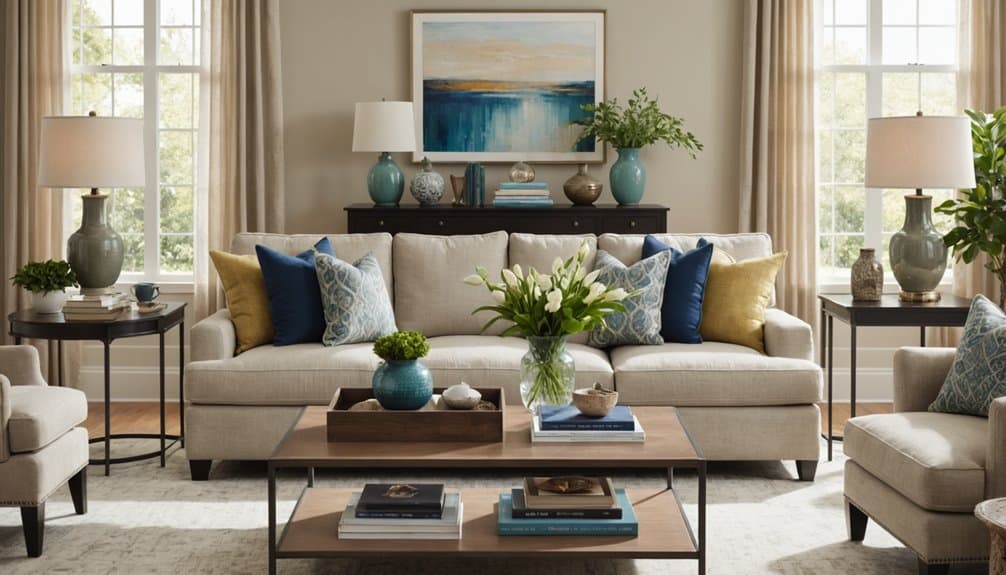
Success in home staging is best measured through a combination of quantitative data and qualitative insights that reveal its impact on the housing market. Remarkably, staged homes sold for 25% more than their unstaged counterparts, with 85% achieving prices 5 to 23% above listing. In addition, staging considerably reduces time on the market; staged properties spent 86% less time listed compared to non-staged ones. Buyers find it easier to visualize a staged home as their future residence, with 82% of agents affirming this perspective.
Ultimately, the measurable return on investment, alongside the heartfelt connection fostered through staging, underscores its effectiveness in creating desirable living spaces that resonate with potential buyers and foster a sense of belonging. Additionally, understanding additional homeownership costs can further enhance the overall appeal of a staged home, ensuring buyers are fully aware of their investment.
Frequently Asked Questions
How Long Does the Home Staging Process Typically Take?
The home staging process typically takes 7 to 14 days and is influenced by factors such as home size, condition, and occupancy status. Professional assistance can improve efficiency and ensure a swift and effective staging experience.
Can I Stage My Home While Living in It?
Yes, you can stage your home while living in it. Focus on decluttering, maintaining cleanliness, and creating inviting spaces. Adapt your daily routines to accommodate showings, ensuring the home remains appealing to potential buyers.
What are the most important areas for Stage First?
The most significant areas to stage initially include the living room, kitchen, and main bedroom. Focusing on these spaces improves first impressions, creates inviting atmospheres, and helps potential buyers visualize their future homes effectively.
How Often Should I Update My Home Staging?
Updating home staging should occur regularly, ideally every season, to align with market trends and buyer expectations. Consistent refreshment improves appeal, ensuring the property remains competitive and inviting to prospective buyers.
Do I Need to Hire a Professional Stager for Effective Results?
Why hire a professional stager when you can channel your inner Picasso? While DIY staging may sound appealing, expert stagers offer invaluable market insights and design expertise, greatly enhancing your home’s appeal and potential sale price.
Essential Home Staging Tips: Key Takeaways for SellersConclusion
To sum up, home staging emerges as an essential strategy in the property market, transforming properties into irresistible showcases that captivate potential buyers. By understanding the nuances of staging, including its benefits and common pitfalls, sellers can improve their chances of a swift and profitable sale. The impact of effective staging can be monumental, turning even the most modest home into a coveted gem. Therefore, embracing home staging is not merely an option; it is a crucial necessity for success.

